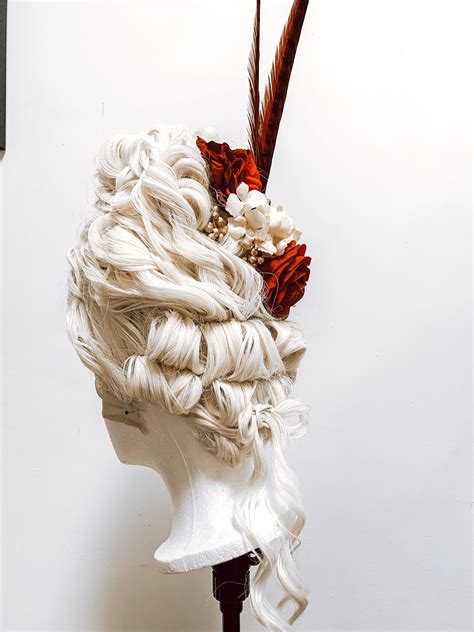French Powder Wig: A Timeless Allure
The French powder wig, an iconic symbol of sophistication and extravagance, has captivated fashion enthusiasts for centuries. Originating in the 17th century, these elaborate hairstyles have undergone numerous transformations, yet their allure remains timeless.

The History of French Powder Wigs
During the reign of Louis XIV, known as the “Sun King,” wigs became a fashion statement among the French aristocracy. These wigs were initially made of natural hair, but as demand grew, cheaper alternatives such as horsehair and wool were introduced. To create the distinctive white color, wigs were liberally powdered with a mixture of wheat flour and talc.
The Different Types of French Powder Wigs
Over time, various styles of French powder wigs emerged, each with its own unique characteristics:
- Peruke: A long, full-bottomed wig that covered the wearer’s shoulders and framed the face.
- Queue: A wig tied at the back and worn with a ponytail or braid.
- Bob: A shorter wig that ended at the neck or jawline.
- Fontange: A towering wig with multiple tiers of curls, often decorated with ribbons and flowers.
The Symbolism of French Powder Wigs
French powder wigs carried significant social and political meanings:
- Status Symbol: Wigs signified wealth and high social standing.
- Hygienic Necessity: Wigs protected the wearer’s natural hair from parasites and dirt.
- Fashion Statement: Wigs allowed individuals to experiment with different hairstyles and express their individuality.
Modern Adaptations of French Powder Wigs
While French powder wigs are primarily associated with the past, contemporary fashion designers have found innovative ways to incorporate elements of these iconic hairstyles into modern looks:
- Asymmetrical Wigs: Modern interpretations of wigs embrace asymmetry, with one side shorter or longer than the other.
- Colored Wigs: Wigs are now available in a wide range of colors, from natural hues to vibrant shades.
- Synthetic Materials: Wigs made of synthetic materials, such as polyester, are less expensive and easier to maintain than traditional wigs.
Top 3 French Powder Wig Trends
In recent years, three distinct trends have emerged in the world of French powder wigs:
- Minimalist Elegance: Modern wigs prioritize functionality and simplicity, with sleek and understated designs.
- Deconstructed Forms: Wigs with exaggerated proportions and abstract shapes challenge traditional notions of beauty.
- Textured Styles: Wigs feature intricate textures, such as braids, curls, and waves, adding volume and movement to the hair.
Pain Points of French Powder Wigs
Despite their stylish appeal, French powder wigs have some potential drawbacks:
- High Maintenance: Wigs require regular brushing, styling, and washing, which can be time-consuming and expensive.
- Potential Damage: Poorly maintained wigs can become tangled or matted, leading to breakage.
- Allergic Reactions: Some individuals may experience allergic reactions to the materials used in wigs, such as dyes or adhesives.
Motivations for Using French Powder Wigs
Fashion enthusiasts are drawn to French powder wigs for various reasons:
- Style and Flair: Wigs offer a unique and dramatic way to enhance one’s appearance.
- Confidence Booster: A well-styled wig can boost self-confidence and make individuals feel more glamorous.
- Versatility: Wigs provide the freedom to experiment with different hairstyles without damaging natural hair.
Common Mistakes to Avoid
When wearing French powder wigs, avoid these common pitfalls:
- Overstyling: Excessive brushing or heat styling can damage wigs quickly.
- Using Harsh Products: Harsh chemicals and detergents can strip away natural oils, leading to dryness and breakage.
- Ignoring Maintenance: Regular maintenance is essential to keep wigs looking their best.
FAQs about French Powder Wigs
Q: Are French powder wigs only for historical events?
A: No, French powder wigs can be incorporated into modern fashion for a unique and eye-catching look.
Q: What materials are French powder wigs made of?
A: French powder wigs can be made of human hair, synthetic materials, or a combination of both.
Q: How often should I wash a French powder wig?
A: The frequency of washing depends on the type of wig and usage. As a general rule, once every two to four weeks is sufficient.
Q: Can I color a French powder wig?
A: Coloring a French powder wig is not recommended as it can damage the hair fibers, especially if the wig is made of human hair.
Conclusion
French powder wigs have evolved from their origins as a symbol of status to become a modern fashion statement. With their versatility and elegance, these iconic hairstyles continue to captivate and inspire contemporary designers and fashion enthusiasts alike. Whether embraced for historical reenactments or incorporated into modern looks, French powder wigs remain a testament to the enduring allure of fashion history.
Additional Information
Table 1: Types of French Powder Wigs
| Type | Description |
|---|---|
| Peruke | Long, full-bottomed wig |
| Queue | Wig tied at the back |
| Bob | Shorter wig |
| Fontange | Towering wig with multiple tiers of curls |
Table 2: Materials Used in French Powder Wigs
| Material | Source |
|---|---|
| Human Hair | Natural |
| Horsehair | Animal |
| Wool | Animal |
| Synthetic Materials | Polyester, Nylon |
Table 3: Maintenance Tips for French Powder Wigs
| Step | Description |
|---|---|
| Brush Gently | Use a soft-bristled brush to remove tangles. |
| Wash with Mild Shampoo | Use a shampoo specifically designed for wigs. |
| Condition Regularly | Deep-condition wigs once a week to keep them soft and hydrated. |
| Air Dry | Allow wigs to air dry naturally to prevent heat damage. |
Table 4: Common Mistakes to Avoid with French Powder Wigs
| Mistake | Consequence |
|---|---|
| Overstyling | Damage and breakage |
| Using Harsh Products | Dryness and color fading |
| Ignoring Maintenance | Tangling and matting |
